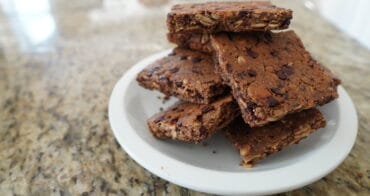 Sometimes you only need some ration bars to get you through a short disaster. A high-calorie, nutrient-dense bar can provide you with sugars, proteins, and carbohydrates to keep you moving and keep you alive. The problem with many bars is that you don’t know what they are putting in them. The other problem is that they can focus on nutrition so much that they taste as good as wet cardboard. While having some granola bars in your inventory is great, when you make a batch of bars yourself, you will find that they taste better, and you know exactly what kind of nutrients and calories you are taking into your body. These are calorically-dense bars that will fuel you up through any disaster.
Sometimes you only need some ration bars to get you through a short disaster. A high-calorie, nutrient-dense bar can provide you with sugars, proteins, and carbohydrates to keep you moving and keep you alive. The problem with many bars is that you don’t know what they are putting in them. The other problem is that they can focus on nutrition so much that they taste as good as wet cardboard. While having some granola bars in your inventory is great, when you make a batch of bars yourself, you will find that they taste better, and you know exactly what kind of nutrients and calories you are taking into your body. These are calorically-dense bars that will fuel you up through any disaster.
Let’s get one thing clear. I am not much of a baker. I have had more than my share of failures trying to develop a good-tasting calorie-dense bar. I can make an occasional loaf of bread and maybe some cookies, and I can cook just about anything else in the world, but baking just isn’t my thing. Sometimes, the trash can is the only place for some of my baking experiments. 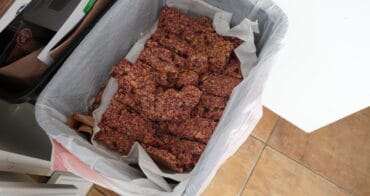 With that in mind, this is my latest calorically and nutrient-dense bar. It might not be the best, but it tastes good and has the calories you would need after a disaster to sustain you. Here we will make a calorically dense, nutritious emergency ration bar with a decent shelf-life. I will take it a step further in this video and take moisture readings from one I left out overnight, one that I dehydrated, and one that I freeze-dried. From this, we can try and determine shelf-life. There are many recipes online for emergency ration bars, and I have tried many. Let’s do this…
With that in mind, this is my latest calorically and nutrient-dense bar. It might not be the best, but it tastes good and has the calories you would need after a disaster to sustain you. Here we will make a calorically dense, nutritious emergency ration bar with a decent shelf-life. I will take it a step further in this video and take moisture readings from one I left out overnight, one that I dehydrated, and one that I freeze-dried. From this, we can try and determine shelf-life. There are many recipes online for emergency ration bars, and I have tried many. Let’s do this…
WHAT YOU NEED
For this recipe, you will need:
Ingredients:
2 cups rolled oats
1 cup almond flour
½ teaspoon salt
1 Tbsp corn starch
1 ½ cups mini semi-sweet chocolate chips
1 cup toasted almond flakes
1 teaspoon vanilla extract
1 banana
1 Tablespoon Chia seeds
2 cups sunflower butter
1/2 cup water (I accidentally used a cup, so I’ll show you how to correct that mistake later in the video)
1 cup coconut oil
You will also need two large mixing bowls, measuring cups, measuring spoons, a large wooden spoon, and a large kitchen knife.
THE RECIPE
Preheat your oven to 325 degrees.
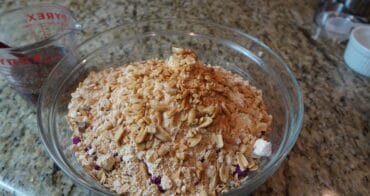 I like to dry toast the almonds slightly to coax out a nice flavor from them. To do this, put them in a non-stick pan, crank the heat and keep them moving in the pan with a spatula. When they start to brown, turn off the heat and put them on a plate or in a bowl to cool. If you leave them in the pan, they will burn and be bitter.
I like to dry toast the almonds slightly to coax out a nice flavor from them. To do this, put them in a non-stick pan, crank the heat and keep them moving in the pan with a spatula. When they start to brown, turn off the heat and put them on a plate or in a bowl to cool. If you leave them in the pan, they will burn and be bitter.
Measure the various DRY ingredients and place them in one of the mixing bowls. One cup toasted almond flakes, two cups oats, one cup almond flour, one tablespoon corn starch, and one-and-a-half cups semi-sweet mini chocolate chips. Stir until all ingredients are well blended.
Separately, blend the salt, vanilla extract, water, coconut oil, chia seeds, and banana in a blender until all ingredients are one. I accidentally used a full cup of water and not a 1/2 cup.
Slowly add the wet blender ingredients to the dry ingredients bowl. Fold in the Sunflower Butter until well mixed, and a moist dough consistency is achieved.
I told you I’m not a baker. To correct this, I added in a tablespoon at a time of flour. You could also add in a bit more oats. This will absorb the excess water, but they will no longer be gluten-free. You want it moldable and for it to stick together, but not batter-like.
Line a cookie sheet with parchment paper. Put the dough into the center of the cookie sheet and press down, and spread it evenly across the cookie sheet. Press well to make sure bars hold together. You want about a one-quarter-inch thickness.
Place the cookie sheet in the oven and bake at 325 degrees for 20 minutes. I had to drain off the oil in the cooking process. Drain off any excess oil. Turn oven down to 175 and bake for an additional 20 minutes. Place the sheet on a wire rack to cool more rapidly. Cut the bars on the sheet. Let cool to room temperature, remove the bars and place them on a wire rack for further drying and cooling.
NUTRITION
These are high caloric bars. Here is a breakdown of the calories and how you can estimate the calories per bar on your final recipe.
316 (corrected from video) calories – 2 cups oats
648 calories – 1 cup almond flour
31 calories – 1 tablespoon corn starch
1206 calories – 1 ½ cups mini semi-sweet chocolate chips
532 calories – 1 cup toasted almond flakes
12 calories – 1 teaspoon vanilla extract
105 calories – 1 banana
138 calories – 1 tablespoon Chia seeds
2,800 calories – 2 cups sunflower butter
1,951 calories – 1 cup coconut oil
This is a total of around 7,739 calories. You can divide this by the number of bars you have made, in my case 24, to give you a general estimate of the calories per bar. In my batch, each bar is roughly 322 calories, and which is two to three times the amount of calories in an average breakfast bar. Each bar has about 26 grams of healthy fats, 8 grams of protein, 19 carbohydrates, and a low 5 grams of sugar. The oats and protein will also help regulate the body’s sugar intake, which will help you avoid sugar spikes and troughs.
Because of the bars’ high calories and high-fat content, you don’t want to just snack on them. I designed these for consumption when you are hiking, engaged in activities, or bugging out, which is why we also need to discuss shelf-life.
MOISTURE AND FOOD PRESERVATION
On the counter, these will probably last for about a week or two, as is, owing to the high-fat content. In your freezer, they could last for years. The coconut oil and the oil in the nuts will turn slightly rancid in taste, and that’s your best test. When it comes to shelf-life, there are four main factors: pasteurization, storage temperature, moisture, and air.
I use the term pasteurization here loosely, as it is more generally applied to liquids. There is probably a better term. I mean the application of heat through the cooking process to kill microbes.  Essentially, all things have bacteria and yeast on them. These single-cell organisms are mostly cooked off your food and reduced in numbers by heating. Even transferring them after cooking, though, exposes them to yeast and bacteria. When it comes to food preservation, we reduce the numbers of these single-cell food consumers and create an environment where they can’t multiply. Still, that can of beans that has been pasteurized is suitable for a max of 5 years. After that, it could be poisonous or even swell up and explode. This is where moisture comes into play. For these single-cell food consumers to multiply, they need water to move around. 38% moisture is enough for them to move around. Zero to 7 percent moisture really isn’t.
Essentially, all things have bacteria and yeast on them. These single-cell organisms are mostly cooked off your food and reduced in numbers by heating. Even transferring them after cooking, though, exposes them to yeast and bacteria. When it comes to food preservation, we reduce the numbers of these single-cell food consumers and create an environment where they can’t multiply. Still, that can of beans that has been pasteurized is suitable for a max of 5 years. After that, it could be poisonous or even swell up and explode. This is where moisture comes into play. For these single-cell food consumers to multiply, they need water to move around. 38% moisture is enough for them to move around. Zero to 7 percent moisture really isn’t.
The other two factors that slow these food spoilers are air and temperature. If there is no oxygen, the food will last exponentially longer. Vacuum sealing could extend the life of these bars, and an oxygen absorber could sequester all the oxygen and extend shelf-life. Dry-ice storing or otherwise replacing the oxygen with heavier gasses could also preserve them longer. Finally, the colder, the better. You will get a longer shelf-life out of food that is stored in a cool pantry or root cellar than you will a countertop or somewhere the temperature fluctuates. I have to mention here another factor– exposure to light, but light will not degrade food as rapidly as these other factors.
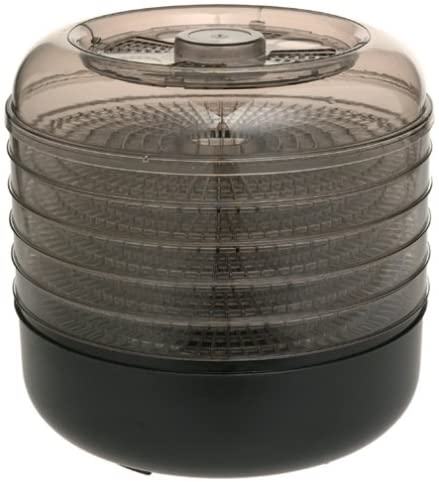 The bars I just baked had a moisture reading of around 45. That’s too much moisture, and it provides too much water for microbial growth, so the bars will eventually mold if they aren’t dried further. This mold can occur to the inside and may not be visible on the outside. That’s why these would have at best two weeks in a sealed container on the shelf. The dehydrator, after 8 hours, brought the moisture down to 38.5%, which is similar to commercial bread. So, like commercial bread, it will last that long on the shelf. For reference, jerky is 23% moisture, so I could probably leave these in the dehydrator for several days and get these down to below 10%, which would be suitable for a couple of months storage in a sealed, oxygen-deprived container.
The bars I just baked had a moisture reading of around 45. That’s too much moisture, and it provides too much water for microbial growth, so the bars will eventually mold if they aren’t dried further. This mold can occur to the inside and may not be visible on the outside. That’s why these would have at best two weeks in a sealed container on the shelf. The dehydrator, after 8 hours, brought the moisture down to 38.5%, which is similar to commercial bread. So, like commercial bread, it will last that long on the shelf. For reference, jerky is 23% moisture, so I could probably leave these in the dehydrator for several days and get these down to below 10%, which would be suitable for a couple of months storage in a sealed, oxygen-deprived container.
The freeze dryer took the moisture level down to imperceptible. When I really worked to find some moisture, I found 7.5 percent moisture, and this was with an additional 8 hours drying time. That level of moisture is equivalent to powdered milk, so it’s super dry. If I seal these in mylar with an oxygen absorber right now, I’m confident they will be suitable for up to 18 months.
__
Having a bar that is high-fat and high-calorie after a disaster can be a lifesaver. You want to know for sure that it’s edible and not spoiled or rancid. Do you have a go-to recipe for a calorie-dense homemade bar or a suggestion on how to store them longer? Let us know in the comments below. I would love to give your recipe a try.
If you would like to see more about the freeze-dryer I am using, you can check it out here: https://bit.ly/2YYjjCw


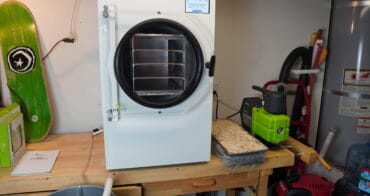
Great article. Saving the recipe and looking forward to giving it a go.
Thanks, Chris, for another helpful video! I could be wrong about this, but I believe if you ground up the chia seeds (using a coffee grinder is super simple), we’ll get more nutrients out of them. They’re typically difficult to digest whole. I can’t wait to make these! Thanks again!
You can use coconut flour instead of regular if you used too much water, it absorbs more water than regular flour and is still gluten free
I “tweaked” your recipe to make it store longer and achieve your goal. I did not add water, salt, nor oil because your ingredients already had sufficient amounts. I left out the corn starch because I am allergic to it. This is the recipe: 1 cup oatmeal, 1 cup unbleached flour, 3 TBS ground chia seeds, 1 cup ground pumpkin seeds (because I am allergic to nuts). I put all this into mixer and blended. I then added 2 c sunflower butter, 1 tsp. vanilla extract, 1 banana, and 1 cup microwave softened white chocolate chips which released more oil. I mix it all together and poured it onto a 17.25 x 11.5 x 1 inch baking sheet lined with parchment paper. I used my rolling pin to level it out. Nothing stuck to the pin because of all the oil already in the sunflower butter. Then I used an empty and cleaned tomato sauce can to roll everything 1/4″ thick and straightened out all to the pan edge. I baked it at 325 for 20 minutes and then reduced heat to 175 for another 20 minutes. I air dried on racks overnight. I was very pleased with the taste and texture. I did deyhdrate the bars the next day for 2 hrs at 115 degrees before vaccum sealing the bars. I will watch to see if there is any deterioration within the jars.
Thank you for all you and your prepping group do to alert us and help to prepare us for what is coming down the pike.
That’s awesome. Thank you!